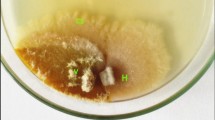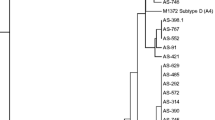Abstract
The effects of virus strains on the virus transmission in Cryphonectria parasitica were observed in this study. In laboratory assays by replicating vegetative incompatibility (vic) genotypes in independent fungal isolates, we quantified the transmission of three CHV1 viruses between isolates heteroallelic at one or two vic loci, and demonstrated that different CHV1 virus isolates determined their transmission abilities. The results suggested that using the hypoviruses with higher transmission abilities could increase the efficiencies of the biological control of chestnut blight.
Similar content being viewed by others
References
Anagnostakis S L. Biological control of chestnut blight. Science, 1982, 215: 466–471
Grente J, Sautet S. Biological control of chestnut blight in France. In: MacDonald W L, Ceeh F C, Luchok J, et al., eds. Proceedings of the American Chestnut Symposium. Morgantown: West Virginia University Books, 1978. 30–34
Hepting G H. Death of the American chestnut. J For Hist, 1974, 18: 60–67
Chen B S, Nuss D L. Infectious cDNA clone of hypovirus CHV1-Euro7: A comparative virology approach to investigate virus-mediated hypovirulence of the chestnut blight fungus Cryphonectria parasitica. J Virol, 1999, 73: 985–992
Craven M G, Pawlyk D M, Choi G H, et al. Papain-like protease p29 as a symptom determinant encoded by a hypovirulence-associated virus of the chestnut blight fungus. J Virol, 1993, 67: 6513–6521.
Nuss D L. Biological control of chestnut blight: an example of virus mediated attenuation of fungal pathogenesis. Microbiol Rev, 1992, 56: 561–576
Anagnostakis S L, Day P R. Hypovirulence conversion in Endothia parasitica. Phytopathology, 1979, 69: 1226–1229
van Alfen N K, Jaynes R A, Anagnostakis S L, et al. Chestnut blight: Biological control by transmissible hypovirulence in Endothia parasitica. Science, 1975, 189: 890–891
Heiniger U, Rigling D. Biological control of chestnut blight in Europe. Ann Rev Phytopathol, 1994, 32: 581–599
Wang K R, Shao J Y, Lu J Y. On vegetative compatibility of Cryphonectria parasitica in Jiangsu and Anhui (in Chinese). J Nanjing Agri Univ, 1991, 14: 44–48
Liu Y C, Milgroom M G. Correlation between hypovirus transmission and the number of vegetative incompatibility (vic) genes different among isolates from a natural population of Cryphonectria parasitica. Phytopathology, 1996, 86: 79–86
Cortesi P, McCulloch C E, Song H, et al. Genetic control of horizontal virus transmission in the chestnut blight fungus, Cryphonectria parasitica. Genetics, 2001, 159: 107–118
Bissegger M, Rigling D, Heiniger U. Population structure and disease development of Cryphonectria parasitica in European chestnut forests in the presence of natural hypovirulence. Phytopathology, 1997, 87: 50–59
Milgroom M G, Cortesi P. Biological control of chestnut blight with hypovirulence: A critical analysis. Annu Rev Phytopathol, 2004, 42: 311–338
Ding P, Liu F X, Xu C X, et al. Transmission of Cryphonectria hypovirus to protect chestnut trees from chestnut blight disease. Biol Control, 2007, 40: 9–14
Wang K R, Cheng G Y, Liu Y C, et al. Effects of VC genes and dsRNAs on transmission of dsRNA in Cryphonectria parasitica (in Chinese). Mycosystema, 1997, 16: 30–35
Elliston J E. Characterization of dsRNA-free and dsRNA-containing strains of Endothia parasitica in relation to hypovirulence. Phytopathology, 1985, 75: 151–158
Anagnostakis S L. Cryphonectria parasitica, cause of chestnut blight. Adv Plant Pathol, 1988, 6: 123–136
Carbone I, Liu Y C, Hillman B I, et al. Recombination and migration of Cryphonectria hypovirus 1 as inferred from gene genealogies and the coalescent. Genetics, 2004, 166: 1611–1629
Prospero S, Conedera M, Heiniger U, et al. Saprophytic activity and sporulation of Cryphonectria parasitica on dead chestnut wood in forests with naturally established hypovirulence. Phytopathology, 2006, 96: 1337–1344
Milgroom M G, Lipari S E. Population differentiation in the chestnut blight fungus, Cryphonectria parasitica, in eastern North America. Phytopathology, 1995, 85: 155–160
Milgroom M G, Wang K, Zhou Y, et al. Intercontinental population structure of the chestnut blight fungus, Cryphonectria parasitica. Mycologia, 1996, 88: 179–190
Milgroom M G, Cortesi P. Analysis of population structure of the chestnut blight fungus based on vegetative incompatibility genotypes. Proc Natl Acad Sc USA, 1999, 96: 10518–10523
Wang K R, Liu Y C, Milgroom M G. The VC genotypes in chestnut blght fungus, Cryphonectria parasitica. In: Tan W Z, ed. Recent Research Achievement of Yong Mycologists in China (in Chinese). Chongqing: Southwest China Normal University Press, 1995. 126–130
Cortesi P, Milgroom M G. Genetics of vegetative incompatibility in Cryphonectria parasitica. Appl Environ Microbiol, 1998, 64: 2988–2994
Huber D H. Genetic analysis of vegetative incompatibility polymorphisms and horizontal transmission in the chestnut blight fungus Cryphonectria parasitica. Doctor Dissertation. East Lansing, MI: Michigan State University, 1996. 1–10
Anagnostakis S L. Conversion to curative morphology in Endothia parasitica and its restriction by vegetative compatibility. Mycologia, 1983, 75: 777–780
Peever T L, Liu Y C, Cortesi P, et al. Variation in tolerance and virulence in the chestnut blight fungus hypovirus interaction. Appl Environ Microbiol, 2000, 66: 4863–4869
Papazova-Anakieva I, Sotirovski K, Cortesi P, et al. Horizontal transmission of hypoviruses between vegetative compatibility types of Cryphonectria parasitica in Macedonia. Eur J Plant Pathol, 2008, 120: 35–42
Anagnostakis S L. Chestnut blight: The classical problem of an introduced pathogen. Mycologia, 1987, 79: 23–37
Liu Y C, Milgroom M G. High diversity of vegetative compatibility types in Cryphonectria parasitica in Japan and China. Mycologia, 2007, 99: 279–284
Liu F X, Ding P, Xu C X, et al. Genetic Diversity of Cryphonectria hypovirus 1 in China, Japan and Italy. J Phytopathology, 2007, 155: 662–669
Biella S, Smith M L, Aist J R, et al. Programmed cell death correlates with virus transmission in a filamentous fungus. Proc R Soc London B, 2002, 269: 2269–2276
Glass N L, Kaneko I. Fatal attraction: Noneself recognition and heterokayon incompatibility in flamentous fungie. Eukayyot Cell, 2003, 2: 1–8
Saupe S J. Molecular genetics of heterokaryon incompatibility in filamentous ascomycetes. Microbiol Mol Biol Rev, 2000, 64: 489–502
Smith M L, Gibbs C C, Milgroom M G. Heterokaryon incompatibility function of barrage-associated vegetative incompatibility genes (vic) in Cryphonectria parasitica. Mycologia, 2006, 98(1): 43–50
Clem R J, Fechheimer M, Miller L K. Prevention of apoptosis by a baculovirus gene during infection of insect cells. Science, 1991, 254: 1388–1390
Birnbaum M J, Clem R J, Miller L K. An apoptosis-inhibiting gene from a nuclear polyhedrosis virus encoding a polypeptide with Cys/His sequence motifs. J Virol, 1994, 68: 2521–2528
Chen B S, Geletka L M, Nuss D L. Using chimeric hypoviruses to fine-tune the interaction between a pathogenic fungus and its plant host. J Virol, 2000, 74: 7562–7567
Choi G H, Nuss D L. Hypovirulence of chestnut blight fungus conferred by an infectious viral cDNA. Science, 1992, 257: 800–803
Author information
Authors and Affiliations
Corresponding author
Additional information
Contributed equally to this work
Supported by the National Natural Science Foundation of China (Grant Nos. 30370918, 30470062)
About this article
Cite this article
Deng, Q., Ye, Y., Miao, M. et al. The horizontal transmission of Cryphonectria hypovirus 1 (CHV1) is affected by virus strains. Chin. Sci. Bull. 54, 3053–3060 (2009). https://doi.org/10.1007/s11434-009-0368-z
Received:
Accepted:
Published:
Issue Date:
DOI: https://doi.org/10.1007/s11434-009-0368-z




